|
Only one year did the Chocolate Lilies or Fritillaria affinis (formerly F. lanceolata) cover patches of the meadow as thickly as the first photograph shows. Usually they are in groups of two or three, just waiting for someone to discover their quiet, dark elegance in amongst the riot of colour that the rest of the spring flowers explode in. If we had fields annually I'd be tempted to try a very small sampling of the bulblets that are reported to be tender and delicate and somewhat like rice...only a bit bitter.
0 Comments
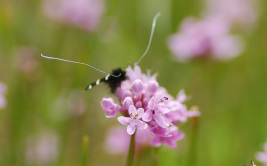 I haven't been able to find out a whole lot about Adela trigrapha! It has the most elegant long white antenna and the three white bars on the wings; thus both the English name and the specific name. I'd like to find a female as she has a fuzzy orange head! This species is found from California north to southern Vancouver Island. The banner across the top of this page shows the sweeping "blush" of Plectritis congesta that fills the places beneath and between the fading shooting stars and fawn lilies. The timing usually matches the subtle blue-eyed mary resulting in a clouds of bold pink, underscored with deep blue. Bumble bees and early flies are often found buzzing about sea blush, finding their way to the cluster of flowers that perch like a head atop the single stalk.
 Lincoln's Sparrow (Melospiza lincolnii) is a small, dapper sparrow that is a passage migrant here at Leaning Oaks. Our records are from 20-25 April and the 15-19 of October, although its likely we have overlooked them at other times since they are secretive sparrows that hide in shrubs. Overall this species has increased on southern Vancouver Island where it is common migrant with increasing numbers also overwintering. There are no documented breeding records for the island, although suitable habitat exists. Leah and I found an agitated male during the summer in Strathcona Provincial Park while we were birding for the Breeding Bird Atlas - which hints that they might be breeding here after all. 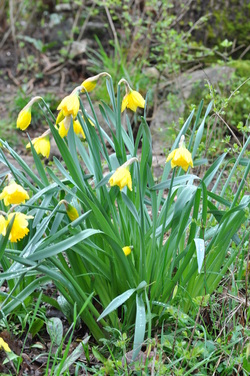 A. You are doing what for species a day?? B. You heard me, the daffodils. A. But is that in the spirit of this exercise? B. They have naturalized in the meadow, haven't they? A. Yes....but...just along the edge! And someone planted them. B. But we didn't; and besides that, did we plant the daphne or Himalayan blackberry or any of the other invasives that have been included here? Have we? A. No. But these are different. B. Why? A. We haven't pulled them out. B. Huh? A. I suppose they aren't just at the edge.... B. I am doing Narcissus pseudonarcissus A. Okay 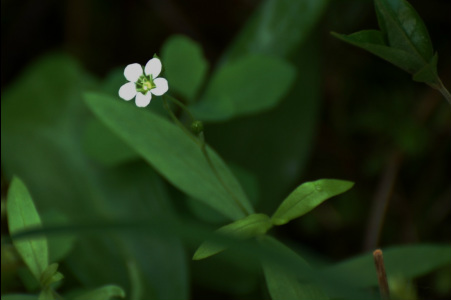 There was a time when many white-flowered plants in the Caryophyllaceae were in a large genus Arenaria, the Sandworts. Nowadays the genus has been split into several genera including Spergularia, Eremogone and Minuartia. This species is in still another genus and is now Moehringia lateriflora - which is considerably more difficult to remember, pronounce - and spell! Blunt-leaved Sandwort grows in both North America and Asia. Here at Leaning Oaks it grows in dry woodland and meadow edge, putting out dainty white five-petalled flowers in April and May. Where ever one travels in B.C. it seems ever present, it grew on my thesis area in the East Kootenays, it grows in the woods along the Tatshenshini River in extreme northwest of the province and in most forests in between. 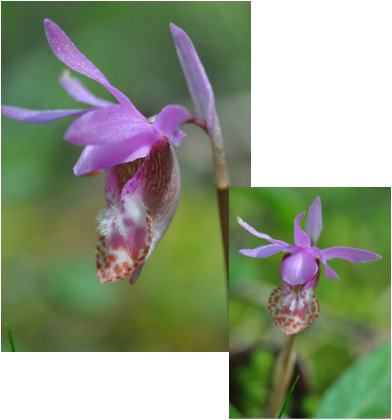 This orchid is found in the shade of the mossy forest and usually growing singly. Calypso bulbosa is a perennial herb grows from corms and I find them in the same location year after year. We have had visitors that can not believe that this exquisite, sweet smelling orchid is native. Despite being relatively common in a few localities, they should never be picked as that will usually result in the corm dying. According to Pojar and Mackinnon, Haida girls ate small quantities of the apparently buttery tasting corm to increase their busts. Don't do this either.  For us, this species has been strictly a spring and fall migrant, noted from the property as they fly overhead, calling. Our records here span the 1-24 of April and then again in the fall from the 26 Sept-18 Oct. This photo is of just a part of a flock of 682 that passed overhead on Sunday; and just one of 3 flocks I saw that day for a total estimated in excess of 1500 birds. Greater White-fronted Geese (Anser albifrons), like many geese and swans, are increasing in numbers, so it is not surprising that this is the highest number recorded at Leaning Oaks Midway through the spring symphony of colour the delicate Lithophragma parviflorum stands tall, swaying gently and popping out with the palest of pale pink petals that look as though they have been cut out of paper and glued to a central disk. The range is southern BC to California and east to Utah and Colorado where it is found in mesic sites.
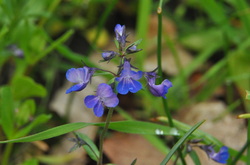 Subtle; Collinsia parviflora appears without the bang of the other meadow flowers.....but one day you look down and there are clouds of blue drifting between the grasses and other more brilliant blooms. There is a "large-flowered" version as well that are only a few millimeters larger. More subtleties! 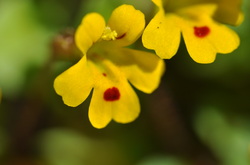 This tiny, cheery annual grows in vernal wet seeps. The thick masses of Mimulus alsinoides look like a solid yellow river tracing these seeps along a west facing cliff. As long as it doesn't get too warm or dry, they will last for a month or so. The red dot looks as though it must be a guide or landing pad for some pollinator but neither of us have seen anything on these flowers or can find a reference to a pollinator. Large showy trilliums are found in the moister, shadier lower lying areas of Leaning Oaks. Trillium ovatum are found nestled among the willows and below the cedars. The flowers change to pale pink as they age and when I was first on the coast I was convinced that they had to be two different species. The seeds are attractive to ants which will drag them back to their nests for the larvae to feed on and thus effectively dispersing the plants.
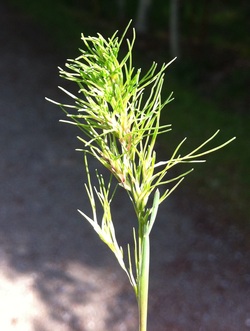 Bulbous Bluegrass (Poa bulbosa ssp. vivipara) is an introduced grass that grows in disturbed areas and dry places. Its a very distinctive grass because, instead of producing flowers and seeds like grasses usually do, the inflorence produce small bulbs which start to grow on the flowering head. As the summer approaches, this grass usually dries up, and the bulbs fall off and loose their leaves, but are able to resprout with autumn rains. This species has had an interesting history. First used in the west as an agricultural crop it was promoted as a weed control in alfalfa fields, where this grass could outcompete other species. Now it in itself is regarded as a weed in some parts of western North America. 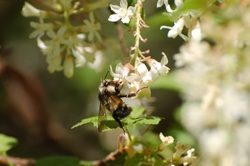 A number of years ago, Leah started working a lot on Dragonflies and Damselflies and it was quite exciting to see her delve into a new group of organisms and begin to get to know them. I decided that perhaps I should do the same and trying to learn the Bumble Bees would be fun. I was completely unprepared for how challenging Bumble Bee identification would be and how interesting this group of insects are. Couple that with increasing conservation concern for the rapid declines in some species (and rapid increases in others, as it turns out) it made for an interesting - if challenging area. One of the challenges is that many of our common species have different colour patterns. This species for instance, has a number of colour forms and is one of the species that often has a large area of orange on the abdomen. Others, like the one in the photograph here is black and yellow only, with no orange. The black and yellow only colour pattern is increasingly common as you move south, so that it is the predominant colour pattern in the western states. Yellow Head (Bombus flavifrons) is an early species here, Queens start becoming active in April. Bumble Bee identification here has been assisted greatly by the arrival of a new book in the past month: Williams et al. 2014. Bumble Bees of North America-an Identification Guide. Princeton University Press.  This is our commonest woodpecker at Leaning Oaks. At this time of year their loud and varied calls can be heard through out the day. They are frequent visitors to our suet feeders, where they are definitely the messiest of the species that use them. Fortunately Varied Thrushes, Dark-eyed Juncos and other species are always around to clean up the spilled suet. Almost every winter we get a bird or two with yellow instead of orange feather shafts and undertail feather colour. These are usually hybrid birds between "red-shafted" and "yellow-shafted" forms. Northern Flickers use our larger nest boxes as night time roosts, but they are very difficult to see entering them. They enter the boxes at dusk and at considerable speed - blink and you miss it.  The shootingstars form thick, patchy mats around the property. The flowers range from deep, deep purple to the odd white one. We transplanted a few plants from areas where they were growing thickly and not flowering (deep shade) to the lawn and these have spread to thick clumps in just a few years. Another English name for Dodecatheon hendersonii is "mosquito bill" which aptly describes the shape of the flower with it's strongly reflex petals exposing the pointy corolla. The round to oval leaves form a basal rosette. D. hendersonii is found on the west coast of North America from southern Vancouver Island to California in areas with moist winters and dry summers. 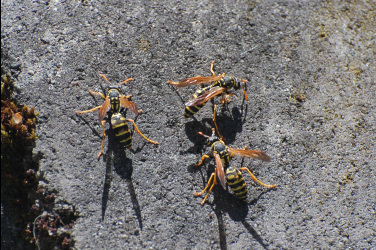 This is a recent arrival in B.C., with the first record from the province in 2003. Polistes dominula ( P. dominculus) spread quickly and our first record here at Leaning Oaks occurred in 2005. This species looks superficially like our native Paper Wasps and Yellow Jackets, but they are thinner-waisted and fly with their back legs dangling, which gives them a distinctive appearance. The make paper nests, but these lack the familar outer envelope of our Paper Wasps and Bald-faced Hornets. Instead the honeycomb shaped paper cells are plainly visible and guarded by attendant wasps. Biologically this is a fascinating species, with a lek breeding system, multiple founders at a colony, worker specialisation and swarming behaviour in the fall. The numerical increase and speed of spread is a bit alarming, and they can be at very high densities. They feed heavily on insects, especially caterpillars and the effect of this new species on our local ecosystems is not known. Nests are usually placed 1-2 meters above ground, often near or on human build structures. We have seen them on cedar-rail fences, in the brackets that hold our hot tub cover, mailboxes, under picnic tables, inside bird houses, in wood bins and under deck railings. The paper describing the discovery of this species in B.C. can be found here: http://journal.entsocbc.ca/index.php/journal/article/view/82 There is no doubt that this is the showiest native shrub that we have at Leaning Oaks. It is a valuable shrub for it's early bloom and ability to attract both species of Hummingbirds. Indeed the arrival of Rufous Hummingbirds seem to be timed to take advantage of Red-flowering Currant and Salmonberry blossoms. In British Columbia, the commonest flower colour is red (pink is commoner further south) but even here we have found plants in the wild that run from white, blush, various shades of pink to brick red and intense scarlet. Not surprisingly, this is a widely available native plant in nurseries. My garden blog on this species is the viewed blog I have written, which shows the interest in this plant. Click here for that blog, which contains a list of some of the cultivars that are available for this species:
http://gardennotesfromleaningoaks.blogspot.ca/search?updated-min=2010-01-01T00:00:00-08:00&updated-max=2011-01-01T00:00:00-08:00&max-results=7  Purple Dead-Nettle is a distinctive introduced species that is frequently found in disturbed places and lawns on southern Vancouver Island. At Leaning Oaks it varies from year to year how much of this we have, and it is a common weed in our garden. The purple leaves on the flowering shoots are showier than the flowers themselves, and nearly the same colour. Lamium purpureum var. purpureum is in the same genus as Yellow Archangel (32.) and since both are weeds here, I must admit that its has discouraged me from using other species of Lamium in the garden. This species is usually an annual or biennial plant. They produce huge quantities of small seeds, in the hundreds or thousands. Irrigated, they continue to bloom well into the summer or fall. "Dead"-nettle refers to the fact that the species superficially looks like stinging nettle, but is "dead" or stingless. 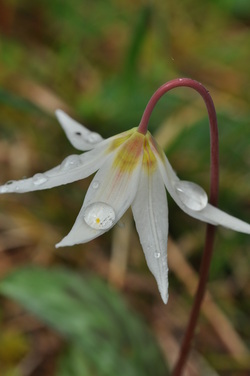 The white fawn lilies congregate in moist, well drained soils; going for dappled sunlight (or is it dappled shade?) Erythronium oregonum glow and offer a counterpoint to the shooting stars that come up just a bit later in the waves of colour that sweep Leaning Oaks in the spring. The deer are very good at nipping off the buds; which reminds me of a line I overheard in a nursery; "I want to grow native plants so that the deer won't eat them". Huh? The overlooked part of the lily is the patterns on the basal, lanceolate pair of leaves. They are a bit like the distinctive patterns on a giraffe; if lilies migrated, you could track individuals. |
AuthorsTwo biologists on a beautiful property armed with cameras, smart phones and a marginal knowledge of websites took up the challenge of documenting one species a day on that property. Join along! Posts and photographs by Leah Ramsay and David Fraser (unless otherwise stated); started January 1, 2014. Categories
All
Archives
May 2025
|
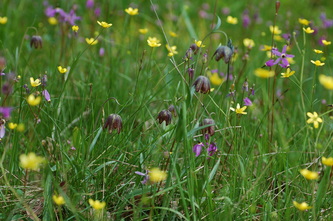
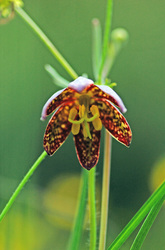
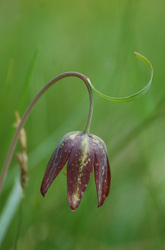
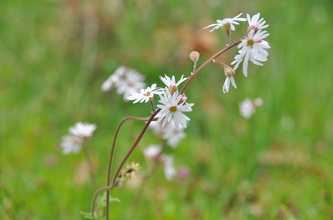
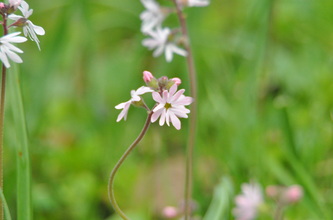
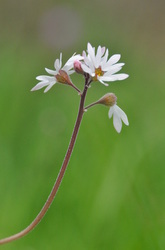
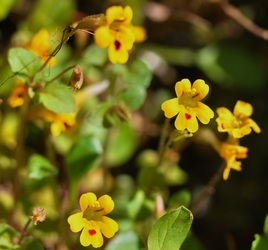
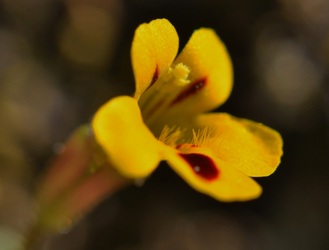
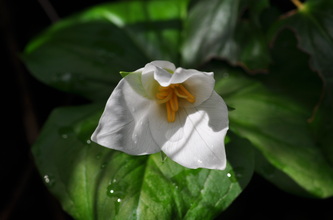

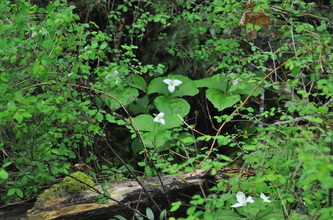
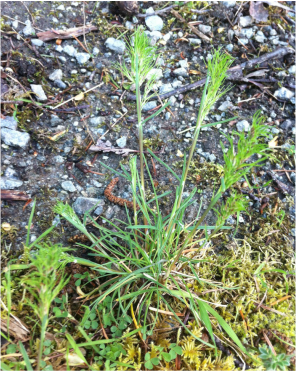




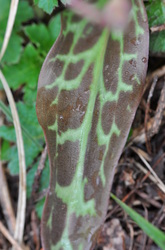

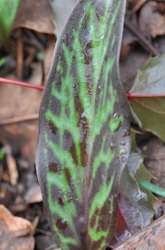
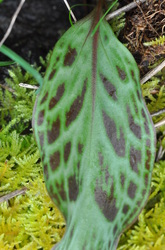
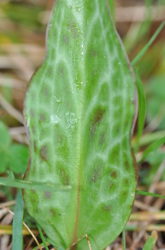
 RSS Feed
RSS Feed